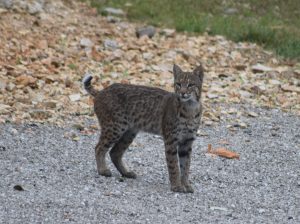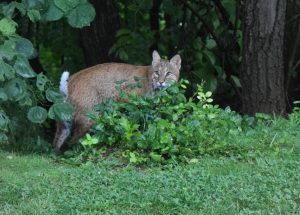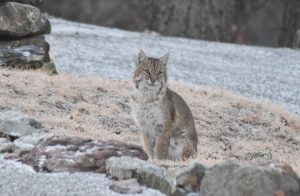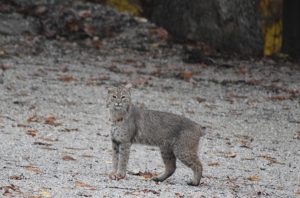Bobcat: Illinois’ Native Cat
By Jennifer Kuroda, founder Illinois Bobcat Foundation

The bobcat (Lynx rufus) is one of the more interesting and beautiful of our native wildlife species in Illinois. This handsome animal has tufted ears, a tawny coat with black spots, and a ruff of fur that flares from its cheeks and neck. Because they are apex predators, keeping a healthy population of bobcats is essential to maintaining biodiversity for a functioning ecosystem.
Historically, bobcats lived throughout Illinois, but habitat changes and unregulated hunting caused their numbers to decline dramatically by the late 1800s and they were nearly extirpated by the mid-1900s. They were first protected in 1972 and were placed on Illinois’ official list of threatened species in 1977. Responding well to that protection and habitat restoration, the population rebounded during the 1990s to the point that there were bobcat sightings in 99 of the state’s 102 counties, making them a conservation success story. Eventually this led to their removal from the list of state threatened species list in 1999.

The state’s current bobcat population is an estimated 3,000 – 5,000. The southernmost counties are the most densely populated. While they prefer forested areas, bobcats are adaptable and will take advantage of old barns and sheds that, at times, are surprisingly close to humans. At a distance, a bobcat will tend to appear much larger than their actual size, which is only about twice the size of a house cat. They are most active at dusk and dawn and are seldom seen during the midday hours, although this changes with the mating season or during times of scarce food supplies.
Illinois resumed bobcat hunting and trapping in 2016, but not without controversy. Proponents warned that the population must be controlled or it would negatively impact turkey and deer populations. Trail cameras have captured bobcats attacking deer, but whether such killing is commonplace is not clear. Southern Illinois University (SIU) researchers found remains of deer in just three stomachs of 91 dead bobcats; and it was impossible to tell whether the bobcats had killed the animals, or had just stumbled across carrion. Mostly, the research indicates they eat voles, rabbits and squirrels, helping control rodent populations. Opponents noted the only bobcat study at the time was conducted in the southernmost portion of Illinois, which is much different habitat then the rest of the state and, despite being protected for the previous 40 years, recovery has been slow. Bobcats continue to face ongoing threats, including incidental trapping, vehicle collisions, poaching and impacts from habitat loss.

In one of his last acts in office, former Governor Pat Quinn vetoed the bill that established a season for bobcat hunting and trapping. A ban on killing bobcats that began in the 1970s, when the species was in serious decline, was good for both people and bobcats, Quinn wrote in his veto message, and lifting the ban would threaten the state’s ecosystem. “To subject the species to indiscriminate killing for recreational amusement presents many serious risks and costs without much in return,” Quinn wrote.
The Illinois Department of Natural Resources (IDNR) sold 500 bobcat hunting permits by lottery during that first season; 6,416 people applied for a permit, thus loosening bobcat protections. While the IDNR declared its first bobcat hunting season a success, groups that opposed the legislation, like the Illinois Bobcat Foundation, kept the pressure on and supported making changes to the legislation to tighten protections for bobcat. The 2019-2020 season brought changes to 17 Ill Admin Code 550 and 570 that included the expansion of counties previously closed to hunting. Adopting the expanded geographic boundaries is problematic because the IDNR has not conducted any further bobcat population studies to show that those geographic areas are still acceptable. Findings from a recent study at Western Illinois University (WIU) demonstrate population densities that are lower than previous research studies conducted in the southernmost region of the state. They estimated bobcat density at 1.40 individuals (range = 1.00–2.02)/100 km 2, which is considerably below previously reported densities (30.5 individuals/100 km 2) and among the lowest yet recorded for the species.

Bobcats in Illinois were once almost driven to the brink of extinction due to over-hunting, trapping, and loss of habitat. Now they face the same threats that led to their demise in the first place. Kevin Hansen, author of Bobcat: Master of Survival, stated, “Whatever the future holds for L. rufus, it is too important to be left in the hands of businessmen, politicians, or wildlife managers. An informed, caring, and engaged public is critical to the conservation of bobcats and all wildlife.”
CLIFFTOP, a local nonprofit organization, is focused on preserving and protecting area blufflands.
A version of this article appeared in the March 20, 2020 edition of the Monroe County Independent and the March 23, 2022 edition of the Republic-Times.
©2020 all content rights reserved Clifftop NFP
Comments are currently closed.
